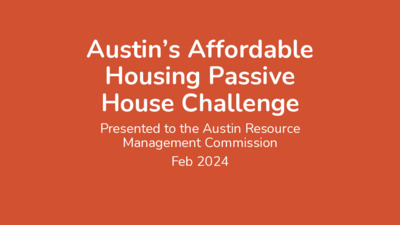Item 10: Passive Housing Presentation 1 of 3 — original pdf
Backup

Austin’s Affordable Housing Passive House Challenge Presented to the Austin Resource Management Commission Feb 2024 Austin RMC 2.2024 Heating and cooling buildings accounts for one-fourth of global energy-related carbon emissions Austin RMC 2.2024 Austin RMC 2.2024 Austin RMC 2.2024 PASSIVE HOUSE BENEFITS DRAMATIC PEAK LOAD REDUCTION AND SHIFT Austin RMC 2.2024 PASSIVE HOUSE BENEFITS DURABLE NO DUST NO NOISE ENERGY EFFICIENT HEALTHY RESILIENT NO UNWANTED MOISTURE OR ODORS Austin RMC 2.2024 Austin RMC 2.2024 Austin RMC 2.2024 20 States have PH incentives in their low income housing tax credit scoring (QAPs) Austin RMC 2.2024 2017/2018 Massachusetts created a Passive House Challenge Program Austin RMC 2.2024 8 Projects (543 units) funded, Incremental costs were ~2% Energy use in these buildings is 50-70% below their peers Austin RMC 2.2024 As of January 2024 all multi family projects above 12,000 sf are mandated to certify with PH for energy code compliance in stretch code jurisdictions in MA (jurisdictions include Boston, Brookline, Watertown, Somerville, Cambridge, Acton, Aquinnah, Arlington, Concord, Lexington, Lincoln, Maynard, Newton, Sherborn, Stow, Truro, Wellesley, Wellfleet). Austin RMC 2.2024 Meanwhile in PA: Notably, the Passive House projects don’t seem to be more expensive to build than conventional buildings, likely thanks to the early integrated design process that development teams are compelled to engage in so that their LIHTC proposals can be competitive. According to Pennsylvania Housing Finance Agency (PHFA) data, the construction cost premium for Passive House versus conventional projects was 5.8% in the first year, 1.6% in the second, and minus 3.3% in the third year, suggesting that learning and innovation by project teams may be driving down costs over time. LOCAL TEST DRIVES Zilker Studios • Austin, TX • 110 Units Integral Care • Austin, TX • 60 Units Temenos • • Houston, TX 95 Units 30.23 kBTU/sq. ft. 33.81 kBTU/sq. ft. PHIUS Optimized: 22.55 kBTU/sq. ft. 25.4% Reduction PHIUS Optimized: 23.52 kBTU/sq. ft. 30.4% Reduction 39.64 kBTU/sq. ft. PHIUS Optimized: 31.62 kBTU/sq. ft. 20.2% Reduction Zilker Studios • Austin, TX • 110 Units Integral Care • Austin, TX • 60 Units Temenos • • Houston, TX 95 Units And… all of these have open air corridors, which is difficult with a PH project. Enclosing the corridors nets an additional 25% EUI reduction! Zilker Studios • Austin, TX • 110 Units Integral Care • Austin, TX • 60 Units Temenos • • Houston, TX 95 Units Austin RMC 2.2024 The pitch $4,000,000 (total, over next 4 years) to fund a challenge program. Projects in Austin that are receiving funding from RHDA Program could apply $4,000 per unit – paid as a grant to developer $1,000 for commitment, hiring a passive house consultant and rater $1,500 at Design Certification $1,500 at Project Certification (end of construction) Projects commit to opening their books for cost add of certification (hard and soft) comfort, indoor air quality, energy use and grid benefits (demand reduction and peak shift) and to participate in a performance tracking program to measure occupant Certifying projects receive an additional $5000 per unit tax credit under Inflation Reduction Act due to ZERH program nesting within PH program. Austin RMC 2.2024 Why do this? Proof of Concept – PH projects can be done here, are not difficult or expensive and yields superior buildings - does PH deliver claimed benefits in our climate? Market Shift – significant reduction in first cost delta once a few projects have been built and the design, construction and supply community learns and reacts Only upside – funds are going towards building healthier, more efficient buildings for most vulnerable people in Austin, and are matched 125% by federal tax credits. Thanks for listening!!